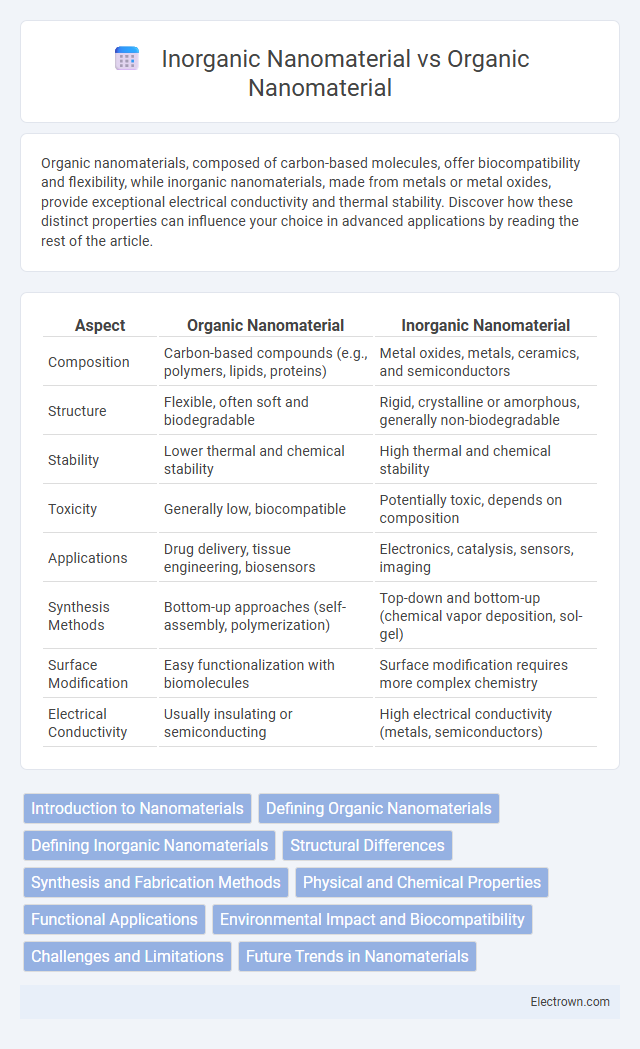Organic nanomaterials, composed of carbon-based molecules, offer biocompatibility and flexibility, while inorganic nanomaterials, made from metals or metal oxides, provide exceptional electrical conductivity and thermal stability. Discover how these distinct properties can influence your choice in advanced applications by reading the rest of the article.
Table of Comparison
| Aspect | Organic Nanomaterial | Inorganic Nanomaterial |
|---|---|---|
| Composition | Carbon-based compounds (e.g., polymers, lipids, proteins) | Metal oxides, metals, ceramics, and semiconductors |
| Structure | Flexible, often soft and biodegradable | Rigid, crystalline or amorphous, generally non-biodegradable |
| Stability | Lower thermal and chemical stability | High thermal and chemical stability |
| Toxicity | Generally low, biocompatible | Potentially toxic, depends on composition |
| Applications | Drug delivery, tissue engineering, biosensors | Electronics, catalysis, sensors, imaging |
| Synthesis Methods | Bottom-up approaches (self-assembly, polymerization) | Top-down and bottom-up (chemical vapor deposition, sol-gel) |
| Surface Modification | Easy functionalization with biomolecules | Surface modification requires more complex chemistry |
| Electrical Conductivity | Usually insulating or semiconducting | High electrical conductivity (metals, semiconductors) |
Introduction to Nanomaterials
Nanomaterials are particles with dimensions typically below 100 nanometers, exhibiting unique physical and chemical properties due to their nanoscale size. Organic nanomaterials consist primarily of carbon-based compounds such as polymers, lipids, and proteins, offering flexibility, biocompatibility, and biodegradability ideal for applications in drug delivery and biosensing. Inorganic nanomaterials, comprising metals, metal oxides, and ceramics, provide superior mechanical strength, electrical conductivity, and thermal stability essential for electronics, catalysis, and environmental remediation.
Defining Organic Nanomaterials
Organic nanomaterials consist of carbon-based molecules such as polymers, lipids, and proteins that exhibit nanoscale dimensions, enabling unique chemical and physical properties. These materials offer biocompatibility, flexibility, and tunable functionalization, making them ideal for biomedical applications and environmentally friendly technologies. Your choice to use organic nanomaterials can enhance interactions with biological systems due to their inherent organic nature.
Defining Inorganic Nanomaterials
Inorganic nanomaterials are composed of non-carbon-based substances such as metals, metal oxides, and ceramics, exhibiting unique physical and chemical properties at the nanoscale. These materials offer high thermal stability, electrical conductivity, and mechanical strength, making them essential in electronics, catalysis, and energy storage applications. Understanding the distinct characteristics of inorganic nanomaterials helps optimize their use in your advanced technological developments.
Structural Differences
Organic nanomaterials consist primarily of carbon-based molecules including polymers and lipids, characterized by flexible, tunable structures with diverse functional groups enabling biocompatibility and chemical reactivity. Inorganic nanomaterials, composed of metals, metal oxides, or semiconductors such as gold, silica, or quantum dots, exhibit rigid, crystalline structures that offer enhanced thermal stability and electrical conductivity. The fundamental structural difference lies in organic nanomaterials' amorphous or semi-crystalline frameworks versus the well-defined lattice structures of inorganic nanomaterials, influencing their mechanical and optical properties.
Synthesis and Fabrication Methods
Organic nanomaterials are typically synthesized through bottom-up methods such as self-assembly, polymerization, and biochemical processes that leverage natural or synthetic organic compounds, enabling precise control over molecular architecture. Inorganic nanomaterials are often fabricated using top-down approaches like lithography and ball milling or bottom-up techniques including chemical vapor deposition (CVD) and hydrothermal synthesis, which allow for uniform particle size and crystallinity. Your choice between organic and inorganic nanomaterials depends on the desired application, as synthesis complexity and structural properties vary significantly between these two classes.
Physical and Chemical Properties
Organic nanomaterials exhibit flexible molecular structures with lower density, enhanced biocompatibility, and tunable chemical functionality due to carbon-based compositions. Inorganic nanomaterials possess rigid crystalline lattices, higher thermal stability, and superior electrical conductivity, often featuring metallic or ceramic properties. Understanding these distinct physical and chemical properties helps you select the optimal nanomaterial for targeted applications such as drug delivery or electronics.
Functional Applications
Organic nanomaterials exhibit exceptional biocompatibility and flexibility, making them ideal for drug delivery systems, biosensors, and tissue engineering applications. Inorganic nanomaterials, such as metal oxides and quantum dots, provide superior electrical, magnetic, and optical properties utilized in catalysis, electronics, and imaging technologies. Your choice between organic and inorganic nanomaterials depends on the functional requirements of your specific application, balancing performance with biocompatibility.
Environmental Impact and Biocompatibility
Organic nanomaterials, derived from carbon-based compounds, generally exhibit higher biocompatibility and lower environmental toxicity compared to inorganic nanomaterials such as metal oxides or quantum dots, which can pose risks due to heavy metal release and persistence in ecosystems. Your choice between these materials should consider that organic nanomaterials tend to degrade more readily in natural environments, reducing long-term ecological impact, while inorganic nanomaterials often provide greater stability and functional diversity but at the cost of potential bioaccumulation and toxicity. Evaluating the balance between environmental impact and biocompatibility is crucial for applications in medicine, agriculture, and environmental remediation.
Challenges and Limitations
Organic nanomaterials face challenges such as limited thermal stability and potential biodegradation issues that can affect their long-term performance in applications like drug delivery and sensors. Inorganic nanomaterials often encounter limitations including potential toxicity, difficulty in surface functionalization, and environmental persistence. Understanding these constraints helps you select the appropriate nanomaterial tailored to your specific technological or biomedical needs.
Future Trends in Nanomaterials
Future trends in nanomaterials emphasize the integration of organic nanomaterials for flexible electronics, biocompatible drug delivery systems, and sustainable energy solutions due to their lightweight, biodegradability, and versatility. Inorganic nanomaterials continue to advance in applications requiring high thermal stability, enhanced catalytic activity, and superior electrical conductivity, particularly in semiconductors and quantum dot technologies. Emerging hybrid nanomaterials combining organic and inorganic components promise unprecedented functionalities, driving innovation in sensors, photonics, and environmental remediation.
Organic Nanomaterial vs Inorganic Nanomaterial Infographic

 electrown.com
electrown.com